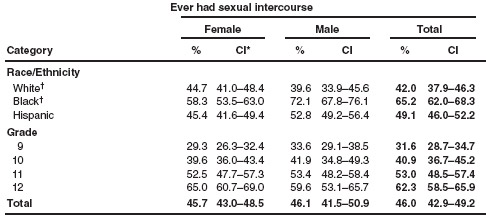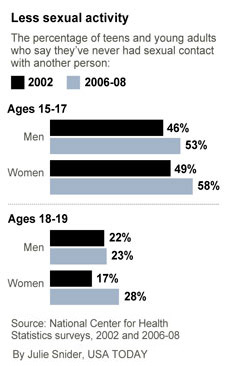Sexually transmitted infections are abundant. Irresponsible – consequence free – sexuality is littered throughout all media. You’d think that more young people are having sex, right? That’s not what the numbers are revealing.
More Young People Waiting
The Center for Disease Control and Prevention (CDC) just released one of the largest, most in-depth national reports to date on sexual behavior among young people in the U.S., studying more than 13,000 people aged 15 to 44, including more than 5,000 aged 15 to 24.
The most surprising result? More kids seem to be waiting for sex.
For instance, among 15 to 17 year olds (using 2006-2008 numbers):
- 58% of girls said they have had no sexual contact.
- 53% of boys said they have had no sexual contact.
Their 2005 study (using 2002 results) found:
- 48.6% of girls said they have had no sexual contact.
- 46.1% of boys said they have had no sexual contact.
Those are encouraging numbers, for sure. USA Today referenced the study and highlighted the fact that even older kids (college-age) are having less sex.
- 27% of young men (ages 15 to 24) said they never had a sexual encounter.
- 29% of young women (ages 15 to 24) said they never had a sexual
encounter.
When the National Center for Health Statistics last studied this age group’s sexual habits, it found only 22% of 15 to 24 year olds said the same. That means more students – from high school and college – are waiting to have sex.
Tagging onto this finding, researchers from Duke University recently polled 1,500 students on the North Carolina campus and found that only a third said they had “hooked up.” Further extending the good news, many of these hook-ups involved only make out sessions, not full-on sexual experiences.
Digging Deeper
Could these numbers be skewed? Some wonder. After all, the statistics from the just-released study are three years old. (That’s just the nature of research; it’s time consuming.) So let’s dig a little further.
The Centers for Disease Control and Prevention’s 2010 Youth Risk Behavior Survey (YRBS) uses 2009 data and breaks down these new findings into even greater detail (and by grade and gender). See table below:

According to this study, 46% of all high school students have had sex. Or to look at it another way, 62% of teenagers have sexual intercourse by the time they graduate from high school. So I’m not celebrating any decreases.
If you want to see the changes over two decades, go to the CDC’s Youth Online site where you can create a custom report based on any YRBS data from 1991 to present day. For example, you can select to view the results about Sexual Behaviors only, and then search the statistics for how many kids have “ever had sexual intercourse.” Then you can select “view all years,” choose “United States,” “All Races/Ethnicities,” and “All Grades” and you’ll see that, in 1991, 54.1% of high school kids had sex, compared to 2009 where just 46% have.
Each of Those Numbers Has a Name
A few years ago, a teenager who grew up under my wing got his girlfriend pregnant. When “Jacob” told me what happened, he was scared and overwhelmed. I was glad that Jacob and his girlfriend decided to keep the baby despite their financial insecurity. Unfortunately, the two of them didn’t stay together, so now Jacob is raising his baby boy on his own.
Life is really difficult for Jacob right now. As much as Jacob loves his little boy, he wouldn’t wish his situation on anybody.
When the number of potential “Jacobs” abstaining from sex grows from 46% to 53%, I guess there’s something to celebrate. But it’s hard to celebrate a small bump in the numbers when I meet more and more people in Jacob’s shoes each week.
Each of those numbers has a name.
Scary Trends
It’s interesting to see these trends change slightly over the years. But if you want an even more telling shift in teenage sexuality, look over the last 50 years. Jim Burns recently interviewed famous abstinence speaker Pam Stenzel on his radio show, and she provided insight into the increase of STDs among young people over the last five decades:
- In 1967—one in 32 teenagers had an STD (now known as an STI – sexually transmitted infection)
- In 1983—one in 18 teenagers had an STD
- Today—one in four teenage girls has an STD
The National Campaign to Prevent Teen and Unplanned Pregnancy sees sexual activity among teenagers as a growing concern. This agency has already cited teen and unplanned pregnancy as a serious challenge in the U.S. For instance,
- At present, nearly three in 10 girls get pregnant by age 20.
- After declining for 14 straight years, the teen birth rate has increased five percent since 2005.
- The rates of teen pregnancy and childbearing in the United States remain far higher than in other comparable countries.
- Seven in 10 pregnancies among unmarried women in their 20s are unplanned.
Our own David R. Smith has seen this increase firsthand in his ministry work on the campus of USF (University of South Florida). More and more college students are coming to David and his wife Jenn, seeking counsel about their sexual promiscuity. On the very day I wrote this article, David counseled a young man about his recent sexual mistakes. David mentioned that their free pregnancy screenings – confidentially held inside their ministry facility – were being used by twenty-something girls at a slightly higher rate than they were three years ago.
Using NCPTUP data, the L.A. Times recently pointed out that, among 18 to 29 year olds, 70% of pregnancies were unwanted, and both genders in this age group suffer the highest rates of STIs (including chlamydia, gonorrhea, and syphilis). The article reveals some reasons for the disconnect between their professed understanding of “safe sex” and what amounts to ignorance and misinformation.
For example, 27% in this age group have no health insurance; that means birth control pills cost more…and so do the doctor visits that allow access to them. As a result, 90% of young people claimed to know all they need to know in order to prevent pregnancy, but 80% of guys and 30% of girls also admitted to knowing “very little” about how birth control pills actually work. Further, 24% of this age group believed wearing two condoms increases safety, when it actually increases the chance for breakage (and thus, pregnancy and/or disease).
But sex isn’t just affecting teens’ health (i.e., pregnancy and STIs). Researchers analyzing the National Longitudinal Study of Adolescent Health and the Adolescent Health Academic Achievement Study found a number of regrettable connections between sexually active teens and their deteriorating school performance. Compared to teens who are abstinent or have sex as part of a relationship, teens who merely “hook up” typically earn lower grades (with corresponding lower GPAs), are more likely to be suspended/expelled, are less likely to attend college, and are less attached to school. All sexually active teens (casually or not) were at greater risk of truancy.
So it seems that even though we’re seeing a small drop in sexual activity in the last few years, young people are still paying high prices for their sexual promiscuity, perhaps more than ever before. People like Jacob.
The Older They Get…
The most telling stat from the studies previously mentioned indicates a huge jump in sexual activity during a teenager’s years in high school. Only 31% of freshmen have had sex, but the number literally doubles four years later, as 62% of seniors have had sex.
Backing the CDC’s findings, the “most comprehensive study” on sexuality—the Sexual Behavior, Sexual Attraction, and Sexual Identity in the United States—performed by Indiana University’s Center for Sexual Health Promotion (and underwritten by Trojan Condoms) found that 14% of 14-year-old guys reported having any kind of sexual interaction with a partner in the last three months compared to nearly 40% of 17 year olds.
In other words, both studies say the older teens get, the more likely they are to become sexually active.
The CDC’s biennial Youth Risk Behavior Survey from 2009 (which studies multiple risky behaviors such as riding without seat belts, drinking alcohol, taking drugs, etc.) discovered several interesting points about the sexual lives of 9th- through 12th-grade students (typically 14 to 18 year olds):
- 46% had ever had sexual intercourse.
- 13.8% had sexual intercourse with four or more persons during their life.
- 34.2% had sexual intercourse with at least one person during the three months before the survey.
With these numbers staring us in the face, it becomes obvious that we simply cannot wait to have “the talk” with our teenagers on the night of their junior proms! Nor does it seem we can have just one talk and hope it works.
Because there’s a lot of sex talk going on out there.
Parents and Youth Workers Making a Difference
Parents and youth workers who make it a point to have one-on-one relationships with teens, where true communication (talking and listening) is offered, already know that sex is one of the big traps facing young people. Temptation, messages in media, peer pressure, and the overall culture teens live in point in one direction: Have sex—because everybody’s doing it, and no one will get hurt.
While some may read these reports and think, “Great! The battle is being won; we can relax a bit,” wiser parents and youth workers realize this is the time to take full advantage of even a little bit of momentum and press the issue.
But how we do it is just as important that we do it. Here are a couple of ideas:
- Have ongoing talks about sex…that start earlier rather than later. You can’t pour over these numbers and truly believe that waiting until kids are in high school for “the talk” is an appropriate course of action. Genuine conversations about sex need to be happening well before their first day of freshman year. (And that’s conversationS, if you’ll notice…not one conversation.) We can’t be content that one talk will douse the bombardment they face every day from numerous images and messages pushing sex in our culture. And as you have these ongoing talks, take time to truly listen. Make sure you key in on differences over time regarding your teen’s attitudes and beliefs about sex. If you’re actually getting through to them, their answers will reflect that. This means you have to be asking questions…not merely giving lectures. (I devote an entire chapter in my new parenting book, Candid Confessions of an Imperfect Parent, to creating safe communication arenas where our kids feel safe to open up and share with us.)
- Without using scare tactics, educate teens about the consequences. Fear doesn’t work very well on young people. It never really has. Showing graphic images of car wrecks resulting from intoxicated driving only does so much to prevent it. So does showing kids graphic images of STIs on people’s bodies. Many will still cling to the timeless invincibility associated with youth and believe it “won’t happen to me.” But the risks are still there…even if an STI isn’t the outcome. Here are a few questions – in no specific order – that will generate discussion without putting kids on the defensive:
- Do you believe there are consequences to sexual actions? If so, name some of them. (Don’t let them forget about ensuing regret and heartbreak that comes when a sexual relationship ends.)
- What will an unplanned pregnancy do to your plans for life after high school?
- How will having sex affect your friendships?
- How will having sex affect our relationship?
- How will having sex affect your relationship with God?
Transparent, genuine, and truly empathetic conversations will go a long way toward catapulting the current momentum of teens’ sexual practices into a healthier reality for your teen. If there’s one thing I want to stress, though, it’s this: It won’t happen automatically.
Now is not the time to set the cruise control and lose focus. Now is the time to turn up the heat on preventing teen sex…in loving and practical ways. 













